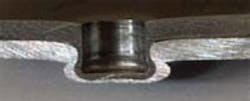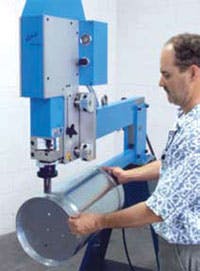Pneumatics for speed, power, and control
When was the last time you heard of electronic controls being replaced by pneumatic controls? If anything, electropneumatic controls are becoming more and more commonplace, so it is rare to find electronics disappearing totally from pneumatically driven machines. However, designers at Eckold AG, Trimmis, Switzerland have good reason to use only pneumatic and mechanical components for carrying out all motion sequences in their patented hit clinching machines.
It would have been simpler, even when constructing the latest Eckold hit-clinch machine, to have used a PLC. “However, there were several reasons for constructing the machine, which is designed for manual operation, without any electronics,” recalls Jrg Scholz, Technical Manager at Eckold.
In a clinch
The hit clinching process for joining metal sheets involves placing one sheet on top of the other, followed by a succession of rapid impacts that result in cold-formed joints. At the same time, undercuts are formed locally from the pieces to be joined to ensure a positive fit. In addition to a clean, tight, joint, other advantages of the hit clinching process include: • low production costs, • no need for any auxiliary joining pieces, and • no heat is required.
By way of a companion unit to fully automate systems for large scale production, Eckold commissioned a hit clinch machine for flexible small volume production with manual component feed at its plant in Trimmis, Switzerland. The machine is operated entirely using compressed air and produces components typically used in air conditioning and ventilation systems, household appliances, and architectural facades.
Where the action is
The actual clinching process occurs in the head of the machine by a pneumatically driven hammer with adjustable power. Compressed air powers a modular linear actuator that operates from differential pressure. The machine operates only when the machine head is lowered; it cannot be actuated unless all elements are in place to eliminate any risk of crushing the operator’s hands or causing other injuries.



